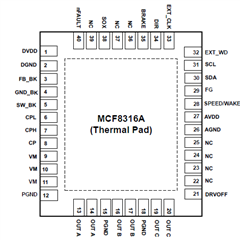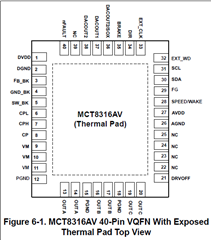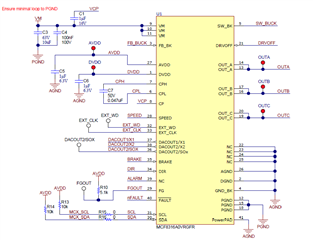Other Parts Discussed in Thread: , MCT8316A, MCF8315A, MCT8315A
Hi,
I'm curious what the difference is with the MCF8316A0V and the MCF8316A1V. My main confusion lies within the two different pinouts. I have attached a couple of screenshots at the end of this post for reference:
The MCF8316AEVM (eval board) is based on the MCF8316A0V and the pinout states that pins 37 and 38 are DACOUT1/XI and DACOUT2/X2, respectively. I can see that the External oscillator circuit, although not populated, does exist on the eval board. Furthermore, pin 36 is labeled as DACOUT/SOx, and pin 39 is labeled as ALARM. When looking at the datasheet for the "MCF8316A" I can see that the pins 36-39 are: NC, NC, SOX, and NC, respectively. I cannot find any documentation regarding the variation within the datasheet for the "MCF8316A" .
This leads me to ask a couple of questions to hopefully clarify:
1. On the eval board, my understanding is that the DACOUT pins are used for an optional external oscillator. Is this correct? And, has this been removed on more recent iterations of the MCF8316 IC?
2. Is it safe to assume that the pinout on the MCF8316 data sheet is correct?
3. Does the "MCF8316A0VRGFR" actually exist, or is this just an arbitrary placeholder for the eval board to host either the MCF or the MCT versions of the IC? I can see that the pinout of the MCT is almost identical to the schematic model in the eval board datasheet, with the only obvious difference being pin 39 (ALARM on the eval board, NC on the MCT pinout).
4. Perhaps the most important question of all: I would like to move forward with designing a motor controller based on the MCF8316A technology. I am of the opinion that the best way to move forward is to assume the datasheet pinout for the MCF8316A is correct, and that I need not worry about DACOUT1, DACOUT2, or ALARM (none of these options would be used anyway). Is this correct?
Thank you for all your help in clearing up some of my confusions. I look forward to better understanding the variations of the motor driver IC family.
Datasheet Pinout for MCF8316A:

Datasheet Pinout for MCT8316A:

MCF8316A0VRGFR from eval board datasheet:
 v
v

